by tmoffett | Jun 20, 2012 | Color, Landscape, Photographic Philosophy
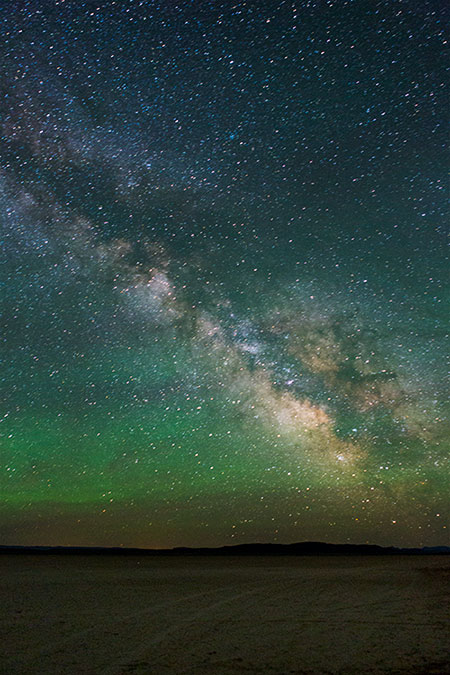
Milky Way
I had never been to the Alvord Desert in Southeastern Oregon, but had heard that it was an interesting place, so yesterday my youngest son and I went to explore. We had no idea what we were in for. All we had was a road map, cameras and sleeping bags. It was just what I needed. A spur of the moment trip to an unknown location that would offer photographic opportunities outside of my “normal” shooting style (comfort zone). When feeling in a rut, this type of activity is one way, at least for me, to get me jump started again. I may not come back with a great piece of art, but it is great for my state of mind.
After a longer than expected drive we finally arrived just a few minutes before the sun dropped below the Steen Mountains, so there was not a lot of time to explore. It has been a while since the area has had rain, so there were many vehicle tracks winding their way around on the playa. Most of my photography has very little reference to man, so this was a bit troublesome for me. I really had to think of ways to use the tracks to my advantage. I was not very successful at that, so I moved to the edge of the playa and focused on the foliage growing up through the playa.
Before long the light was gone, and it was time for us to eat smores and then get ready to photograph the stars. In my 30 plus years in photography, I had never photographed the stars. I have always been the one to get to bed so that I could get up early for sunrise, but on the night of a new moon out in the middle of nowhere, I thought it would be a good time to try something new. Now, I am not sure what took me so long to try this! I can see how this could be addictive.
There are great images just waiting to be made at all hours of the day or night. Even though I may not have come back with that incredible photograph that I am always searching for, I did come home with some new ideas that, at a future time, will become great images.
by tmoffett | Jun 18, 2012 | Color, Photographic Philosophy
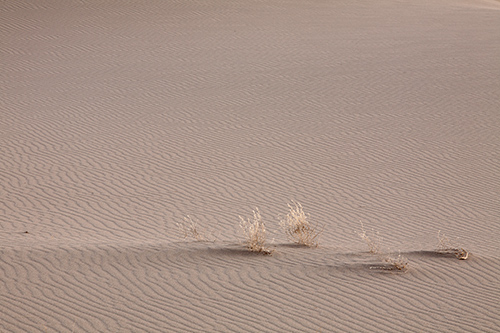
Windswept
Simple is always good. Life feeds us, at least me, too many complications. Maybe that is why I love to isolate the simple things in my photographs. While photographing one evening at Bruneau Dunes State Park, this little clump of brush growing in the barren, windswept sand at the base of the dunes caught my attention. I couldn’t let it go until I had a good image. Sometimes while in the moment, I think that I overwork a scene, but I am not disappointed when I return home and look at what I have photographed. It is that “working a subject to death” process that results in a better image than I would otherwise get. Yes, I may miss something else, but that something else is not what drew me to the scene anyway.
by tmoffett | Jun 14, 2012 | Color, Composition, Landscape
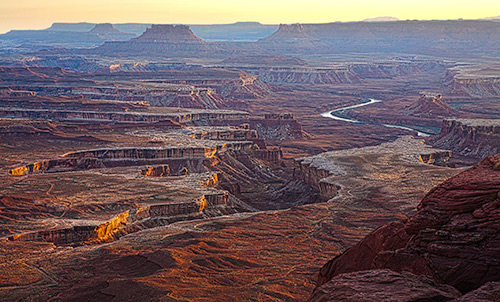
Canyonlands, Green River Overlook
I have been revisiting some images from past photo safari’s that I have taken and found this image from Canyonlands in Southern Utah. This is an area that I would very much like to visit again. The red rock canyons are very unique, and under good lighting conditions seem to glow. It is something that I don’t have here in Idaho (although we do have other features unique to us). I love, in this image, how the setting sun reflects off of the canyon walls, creating a warm glow that opens up the deep shadows deeper in the canyon. It also is full of dynamic lines zigzagging throughout with a dominant S-shaped curve in the river and the extreme depth created by the atmospheric haze. I vividly remember standing on the ledge overlooking the view, wind howling up the side of the cliff, totally in awe of the scene in front of me, wondering how I could do it any justice. I hope in some small way, I have. For me, at least, it reminds me of a very impressive time of my life. I live for these moments.
Next week I will be venturing out again on a much needed photo safari, this time to the Northern California coast. I have fallen in love with the ocean. It is almost therapeutic for me to sit and watch the waves pound the shoreline or gently lap up on a sandy beach. I could sit and watch for hours on end. Trying to create photographs that illuminate my feelings as I watch the waves in action is a challenge that, when successful, I find very rewarding.
by tmoffett | Jun 11, 2012 | Black and White, Landscape, Photographic Technique
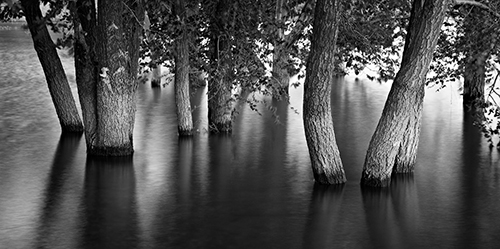
High Water Reflection, Lake Lowell
I just received my new Canon 5D Mark III and had time to go out and test shoot at the lake. I wasn’t really expecting great images, as I wanted to run some tests before using it for a “real” shoot. After looking at the files, I must say that I am quite impressed. Canon has done some great things with this camera.
I have always shot at 100 ISO to keep noise to a minimum, but after shooting a few images after sunset at higher ISO’s, I would not hesitate to use ISO 800 for fine art images. I even had to look hard to find noise at 1600. For sporting events where a little but of noise is acceptable, I would not hesitate to shoot at 25600. The noise structure at higher ISO settings was quite remarkable.
Previous to this camera I have never used auto focus, but after trying out the 61 point auto focus system, I think I might become converted! The ease of changing focus points makes it almost a no-brainer. There are occasions, however, that there is not a focus point far enough off center so that I will have to focus manually. When photographing the landscape on a tripod, for me this does not present much of a problem.
One feature that I really like is the electronic level. I found it to be very accurate and speeds up the framing process. I was composing one image that I was sure I had level, but when checking the electronic level, found that my eye was way off. I photographed both ways, and upon further inspection, found the camera’s level to be correct.
I have not put the camera through a test of all functions yet, but for what I have done, I know that I am going to like it. I can’t wait to get out later this week and continue working with this new tool.
The image posted was made on a windy evening at Lake Lowell at a location that I have photographed many times, but never quite like this. It always amazes me that there is something new to find each time I return to a familiar place. I somehow never tire of this place. Maybe it is that I never tire of photography and am always looking for something new. Training ourselves to see is such an important part of being a photographer. It is not so much training, but becoming aware of our surroundings and seeing life as it unfolds. As we become sensitive to our environment, then the images seem to reveal themselves. It is a wonderful experience to be a part of.
by tmoffett | Jun 5, 2012 | Color, Landscape
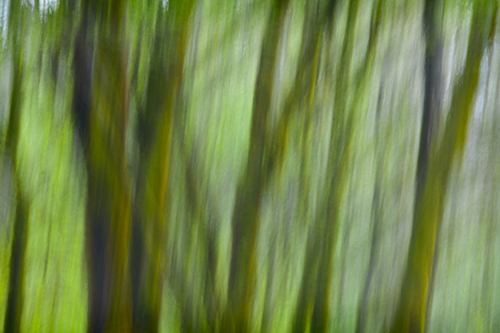
Trees at Dusk, Columbia River Gorge
After photographing waves on the ocean for four days and then waterfalls all afternoon, my whole mindset was motion. When looking at the trees, in my minds eye I could see their branches and leaves blowing in the breeze. The trouble was that there was no breeze! To get the look that I visualized, I moved the camera, creating the appearance of motion. I teach a unit at school in my advanced class on implied motion. I do not use the technique very often, but in this situation it worked perfectly.
My photography is not so much exploratory anymore, it is about creating images of my vision. I will explore whatever technique is needed for that purpose. I prefer to find my vision and then photograph rather than photograph to find my vision. For me, it is much powerful and rewarding that way.







Recent Comments